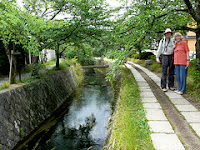


Kyoto's Heian Shrine and Iris Garden lies in the central east part of the Kyoto basin. An enormous red torii gate, the largest in Japan, welcomes you to the street leading up to the main gateway of this comparatively modern Shinto Shrine. Built in 1929, it is 24.2 meters high; the top rail is 33.9 meters long.
Heian Jingu (the Shrine itself) was built in 1895 to celebrate the 1100th anniversary of the establishment of Heian-kyo (the old name of Kyoto). The Shinto shrine honors two emperors: Kammu (737-806), who founded Kyoto in 794, and Komei (1831-66), the last emperor to live out his reign in Kyoto before the capital moved to Tokyo. There are three stroll gardens at Heian Jingu, positioned east, west, and north of the shrine itself. They follow the Heian aesthetic of focusing on a large pond, which is a rare feature at a Shinto shrine. The stepping-stone path that crosses the water is made from the pillars of a 16th-century bridge that spanned the Kamo-gawa before an earthquake destroyed it.

Typical of gardens constructed during the Meiji Era, it is famous for its weeping cherry trees in spring, its irises and water lilies in summer, and its changing maple leaves in the autumn. Bright red Maple seed propellers in a sea of green stood out alarmingly and vividly striped turtles swam enthusiastically and voraciously in pursuit of the bread-crumbs people dropped off the decorative wooden bridge crossing the large lake/pond. The garden is a proliferation of tortured, trimmed, manicured, tamed, bandaged, bondaged(?), persuasively coiffeured trees, arching boughs and cloud-pruned globular formations, rich with dragonflies, unusual mosses and lively birds. Mum and Dad were particularly stoked by the size and dense foliage of the ginko trees that so exceeded anything they had seen before in Australia and especially our gangly little specimen harking from Wahroonga.

The next day, we followed the Philosopher's Walk (a path leading, in our case, North to South, at the foot of the Eastern Kyoto hills, lining a canal and dotted with temples and shrines for its length, many of them edging up the slopes and into the hillside jungle. The Philosopher's Walk is the name given to a 2km(+)-long path through north-eastern Kyoto, along which a philosophy professor from Kyoto University, Kitaro Nishida, used to frequently walk. All along the canal pathway were rows of vibrant hydrangeas, mostly blue and white with occasional pinks, puces and various tones beside the flowing water filled with giant carp pointed upstream. In spring it would be blossoming with the whites and pinks of the cherry and plum trees also lining its banks. First stop was Ginkaku-ji, the Silver Pavilion. Ginkakuji = silver Pavilion (whereas Ginkakuji = gold pavilion). 銀閣寺 (Ginkaku-ji) Constructed by Shogun, Ashikaga


Yoshimasa in the late fifteenth century, intended to be covered in silver leaf like the gold leaf covering of Kinkakuji (Golden Pavilion) but never completed as such. nonetheless it is one of the 5 key Buddhist temples in Kyoto, especially notable for its sand garden pictured here like waves of infinity. The temple features wooded grounds covered with a variety of mosses, and a Japanese garden, supposedly designed by the great landscape artist Soami. The rock and sand garden of Ginkaku-ji is particularly famous, and a pile of sand said to symbolize Mount Fuji has now come to be a part of the garden.


Further on, at Honen-in, we saw a poetry exhibition in the form of calligraphy on suspended scrolls in an annex to the temple in its lush, verdant mossy mosquito-ridden courtyards with raked sand spirals and dripping water from eaves of several-foot-thick straw.

Nanzen-in housed the two-storey giant wooden gate and a remarkably eccentric aqueduct. In the temple garden we saw an all-red dragonfly (eyeballs included) and globs of slimy foam that could only have been frog's eggs hanging from various trees over the pond.
We then caught a taxi to the Traditional Craft Museum, Fereiakan that explains the processes behind many art and craft practices of the many elaborate yet habitually used and socially integrated handworks used by the Japanese, such as bamboo products, silk for koto strings, lacquer-ware, ceramic tiles for wealthy homes and temple roofs, paper lamps, woven, painted

and embroidered kimono fabrics, arrow-making for archery, shirne building for homes, metal work, and incense, to name a few. On two successive nights in Gion, we ate cheerful kushiage and garlic gyoza (at Senmonten inn). We wandered through the lamp-lit streets of low, long wooden traditional houses in the former pleasure quarter looking for a glimpse of a maiko or geisha and listening for the twang of shamisen and voice. Dad was impressed by the splendid arrays of Phalaenopsis orchids in the flower shops for a meagre $150+ but spectacular nonetheless.
























































